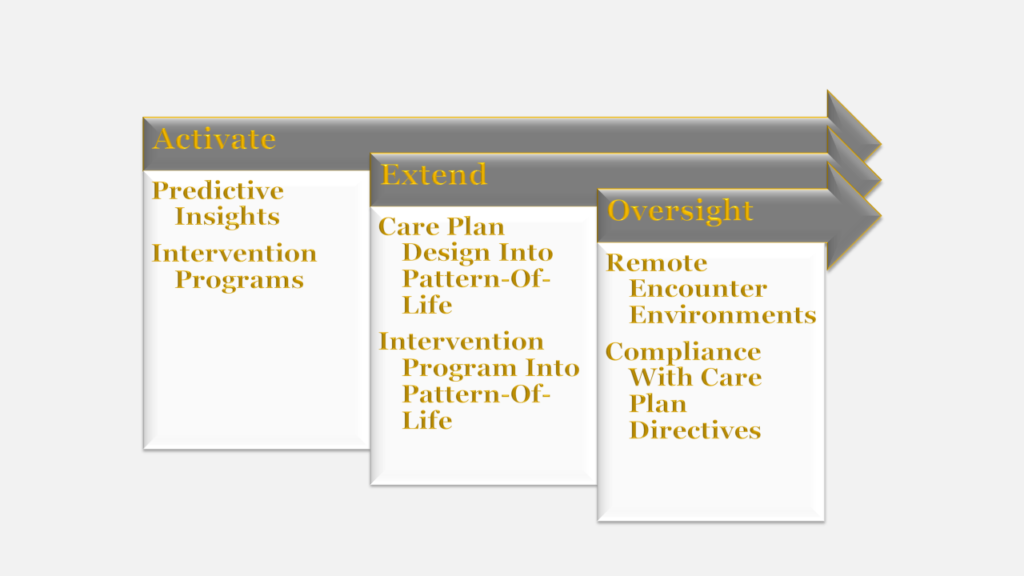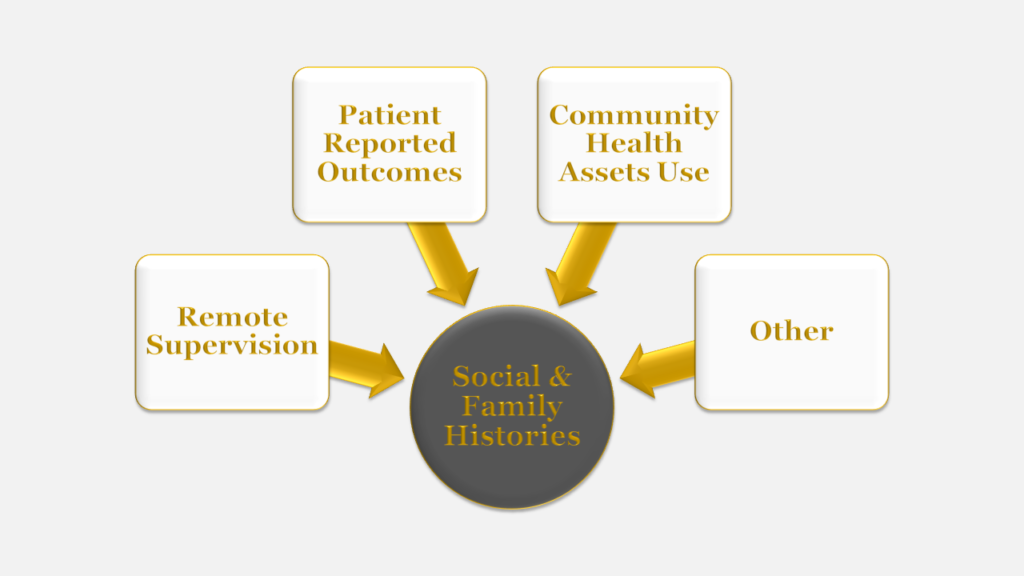METHODS & PROCESSES
Gestalt
The health-related problems we face in our patterns-of-life are moving targets. This complex reality must be reflected in pattern-of-life healthcare methods and processes:
- by presenting a combination of multiple applications working in unison to harmonize the creation and consumption of patient-facing and provider-facing health analytics decisions
- by operationalizing a holistic health decision sciences approach that integrates hardware, software and analytical aspects enabling the deployment of statistical and machine learning algorithms in pattern-of-life environments to capture and analyze data and develop and activate insights from such data
- by activating insights through customized interventional plans, customized patient encounter environments, customized patient reported outcome instruments, managing care plan directives and harmonized provider quality improvement programs and health plans
Predictive Analytics
Our engagement with the pattern-of-life health ecosystem applies predictive analytics to manage frameworks for establishing, expressing and oversighting health risks, including motivation, adherence, compliance and cessation.

Cognitive Analytics
Our engagement with the pattern-of-life health ecosystem and health-related decisioning applies cognitive analytic to activate, extend and oversight predictive analytics insights.

Interventional Plans
Healthcare practices essential to pattern-of-life healthcare solutions must include interventional plans that have value and relevance to the patient as seen through the patient’s lense. These plans must address many inter-related clinical and pattern-of-life factors, while also following evidence-based standard of care guidelines.
Pattern-of-life factors must not ignore the impact of socioeconomic, psychosocial and other social status factors, individual persona factors, gender-influence factors, age related factors and disparities among such factors.
Relevant Modifiable Social Determinants Of Health
Modifiable social determinants of health must be valuable, and therefore relevant, to the pattern-of-life as viewed by the patient. Valuable determinants must be utilized in patient decision-making and medical decision-making.

Patient Persona
The patient’s persona must be recognized as comprising not only general demographic information, but also modifiable social determinants of health.

Extended Histories
Extended social and family histories and other pattern-of-life data relevant to the patient must be captured, analyzed and consumed.

Interventional Strategies
Intervention strategies must account for the most-prevalent commonalities among a patient’s primary condition, its comorbidities and their evidence-based curative intervention algorithms.
Intervention campaigns must be tailored to each patient’s individualized care plan and directed to modifiable social determinants of health and other pattern-of-life factors.
Patient Reported Outcome Instruments
Healthcare artifacts essential to pattern-of-life healthcare solutions must utilize effective patient reported outcome instruments.
Provider Quality Improvement
Healthcare processes and practices essential to pattern-of-life healthcare solutions must include provider organization quality improvement programs that capitalize on pattern-of-life patient and medical decisioning. These programs must chart a course toward realizing the identification and measurement of outcomes and transformative change, including:
- Clarity on what outcomes a provider-organization is trying to drive with pattern-of-life analytical efforts
- Alignment of multiple stakeholders and communities around those outcomes
- Insights and behavioral changes necessary to drive those outcomes

Quality improvement programs must help the provider organization visualize and appreciate the interconnectedness nature of business problems and patient patterns-of-life and prioritize decisions by bringing different stakeholders on to a single platform, including:
- Problem solving without regard to silowed and protected expertise
- Awareness of the interconnectedness and impacts among business problems and their impact by patient patterns-of-life
- Awareness of how the pattern-of-life problems in the provider organization are connected with the performance of healthcare professionals
Health Plans
As payer, provider, employer and consumer relationships align with value-based care, pattern-of-life decision making is required to optimize the activation of key information about each patient, to help health plans engage members and promote optimal health and to support providers in achieving regulated payment incentives.
Health plans and healthcare providers operate in a measures and mandates environment, including:
- “Meaningful use” of healthcare IT and penalties for non-compliance
- Value-based purchasing that links reimbursement to quality, clinical process, patient experience and outcomes within a budget-neutral mandate
- Increasing requirements to report quality metrics
- Readmission reduction programs that penalize hospitals for unnecessary readmissions
- Collectively, these measures and mandates drive Providers to focus on delivering higher quality care at a lower cost
- Pattern-of-life healthcare is a key lever for helping health plans and Providers accomplish this goal
The measures and mandates environment tying payment to health outcomes is producing major shifts in the way healthcare is provided.
- Greater focus on patient engagement, wellness and prevention
- Ongoing investment in sophisticated information technology solutions that will enable Providers to predict when and how intervention is needed, so they can improve outcomes and lower costs
